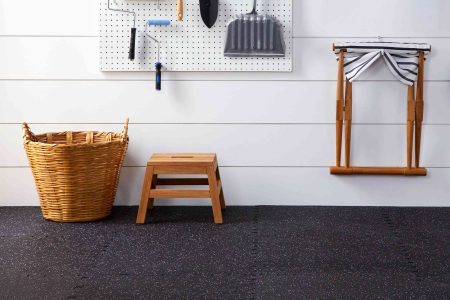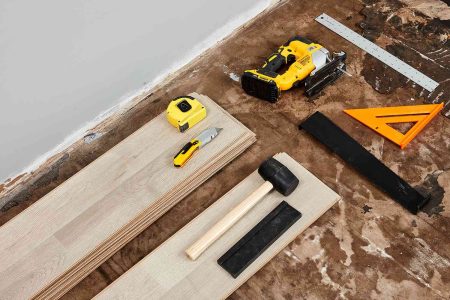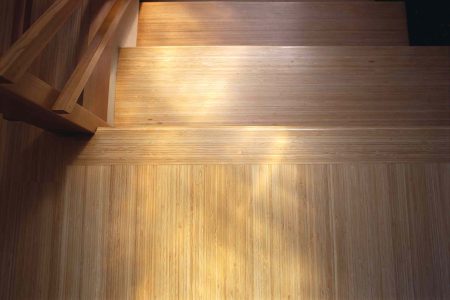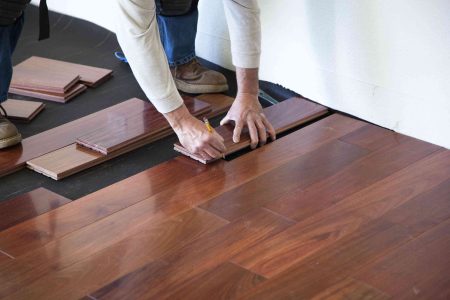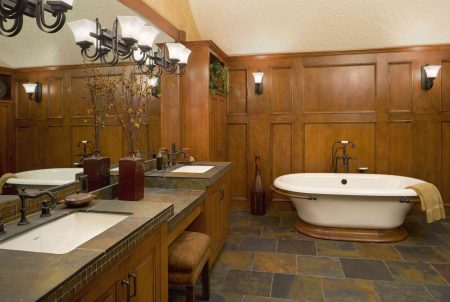The building code generally requires that all stairways with more than four risers be equipped with a grippable handrail for users to hold when then they climb or descend the stairway. Requirements differ from community to community, but most local codes are based on the IRC (International Residential Code) for stair railings. Other organizations maintain their own standards, though they are usually quite similar to the IRC’s.
Both indoor and outdoor stairways must follow some basic requirements:
- Handrails must have a minimum clearance between the handrails and other objects of 2 1/4 inches.
- The standard height of handrails is between 34 and 38 inches, measured vertically from the nose of the stair treads.
- Handrails must be shaped in a manner that allows users to grip them firmly. When the handrail is integrated into the top railing of a guard rail system, it must be contoured in a way to allow for gripping.
- The ends of the handrail cannot have any projections that pose hazards.
- The handrail should be able to withstand a 200-pound load applied in a downward or outward direction, within 2 inches of the top edge of the rail.
An easy way to accommodate the handrail requirement is with a prefabricated handrail bar, cut to the proper length and attached to the wall studs or guardrail newel posts with sturdy brackets. Such a handrail can be installed quickly and inexpensively, and it is a good way to make basement stairs or deck stairs comply with code requirements.
Guardrail vs. Handrail
Code requires that open stairways have a protective guardrail system, usually consisting of vertical posts and balusters topped by an angled rail. But this rail does not necessarily qualify as a handrail, however, unless it lies at 36 to 37 inches above the nose of the stair treads, and is contoured in a manner that allows for a firm hand grip.
It is very common for a secondary handrail to be attached inside the guardrail system in order to meet the code requirements.
Before You Begin
Handrails come in many forms, from simply dowel-like pine rods to elegant milled oak handrails designed to match the design of millwork guardrails. Although installation sounds easy—the railing simply needs to be 34 to 38 inches above the nose of the stairway treads—it can be more complicated than you think. The brackets that anchor the handrail need to be attached to studs or sturdy posts, which don’t necessarily line up with the nose of the treads. Installing the brackets to wall studs or newel posts at a height that ensures the proper handrail height requires very careful measurement and positioning.
What You’ll Need
Equipment / Tools
- Stud finder
- Painter’s tape (optional)
- Pencil
- Tape measure
- Carpenter’s level
- Miter saw
- Drill and bits
- Screwgun
Materials
- Premilled handrail
- 3 Handrail brackets
- 2 1/2-inch stainless steel wood screws
Instructions
-
Locate and Mark Studs
Use a stud finder to locate the studs at the handrail bracket locations. Typically, handrail brackets should be installed so that the handrail will be firmly anchored at intervals no more than 4 feet apart. There should be brackets about 1 foot from the top and bottom of the handrail, as well as at least one in the center. The more brackets you use, the sturdier the handrail will be.
After pinpointing the location of the studs that will anchor the handrail, use a level to mark vertical reference lines on the wall indicating the center of each stud. (You can use painter’s tape to mark the stud if you don’t want to mark the wall with a pencil.)
With exposed stairways that are enclosed with balusters, you may be attaching the brackets to newel posts rather than to wall studs.
-
Cut Handrail to Length
Measure and cut the handrail to the desired length. For ease of gripping, it’s typical for a handrail to extend slightly beyond the top and bottom steps by a distance equal to the width of a stair tread.
If you wish, you can miter-cut the ends of the handrail so the cut ends will form a vertical edge that is perpendicular to the floor.
-
Mark Handrail Height
Using a level and tape measure, mark the wall at a point 36 inches above the nose of the stair treads, at the top, bottom, and middle of the handrail location. These reference marks will show the location of the top edge of the handrail. For proper height, it’s important that you make these vertical measurements from the exact nose of the stair treads.
The height of the handrail can be adjusted slightly if you choose, but remember that the code-dictated height is between 34 and 38 inches.
-
Mark Locations for Brackets
With the aid of one or more helpers, position the handrail against the wall so the top edge is against the reference marks you just drew.
Now, make reference marks on the bottom of the handrail, at the point where the handrail intersects the lines marking the studs. These marks indicate the location of the tops of the support brackets.
-
Attach Handrail Brackets to Wall
Position and attach the handrail brackets to the wall at the reference marks you made on the stud lines. The tops of the brackets should be flush with the bottom edge of the handrail.
-
Attach Handrail to Brackets
Position the handrail so it rests on the brackets, making sure it has the proper overhang at the top and bottom. Secure the handrail to the support brackets with the U-shaped sleeves that fit around the arms of the brackets. Drive the screws in tightly with a screwgun. (With a hardwood handrail, it’s best to drill pilot holes before you drive the screws.)
Read the full article here




